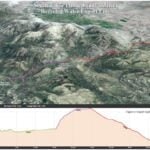Recycled Water Strategic Plan
The South Tahoe Public Utility District developed a Recycled Water Strategic Plan to determine the most cost-effective, innovative, and environmentally conscious way to manage recycled water in the future.
Background
The District collects, treats, and recycles wastewater from the South Lake Tahoe region. An average of 3.9 million gallons per day of recycled water is pumped 26 miles to the District's Diamond Valley Ranch, in Markleeville. Recycled water is stored in Harvey Place Reservoir and released in summer months to be used by ranchers and the District for irrigation.
The District began exporting recycled water to Alpine County in 1967 to comply with state and federal laws such as the Porter-Cologne Act and Public law 96-551. This requirement is unique to the Tahoe region and requires an enormous amount of energy to pump recycled water over mountain passes.
In 1988 the District entered a 40 year agreement to supply recycled water to six ranchers in Alpine County. In 2018, the District began growing alfalfa with recycled water on its Diamond Valley Ranch. In addition to recycling 100% of its wastewater, the District recycles 100% of its biosolids as fertilizer for agricultural land with Bently Agrodynamics in Douglas County, Nevada. The District also annually produces 381,000kw in hydroelectricity as recycled water flows from the top of Luther Pass 2,200 feet down into Hope Valley.
A Strategic Plan
There have been significant advances in and acceptances of water reuse over the last 50 years. As such, the District re-evaluated current operations and practices to identify the best ways to process and use recycled water in the future.
The District completed the original Recycled Water Facilities Master Plan in 2009, which focused on maximizing the utility of our recycled water facilities. The new Strategic Plan looks holistically to determine feasibility, innovation opportunities, hurdles, solutions, possibilities, and new technologies to treat and maximize the beneficial use of recycled water.
See our Recycled Water Facilities Master Plan (2009) to the right.
Location
Recycled water is pumped 26 miles, from South Tahoe PUD’s wastewater treatment to Harvey Place Reservoir in Markleeville, CA. Harnessing the water pressure from recycled water flowing from the top of Luther Pass down into Hope Valley, the District produces 381,000kw of hydroelectricity.
South Tahoe PUD owns and operates a 1,400-acre recycled water facility called Diamond Valley Ranch.
Plan Goals
Analyze and identify options to put recycled water to its highest end use, continue to protect our sensitive environment, and be cost-effective.
Educate, inform, and engage the public and a Stakeholder Advisory Group (SAG) to obtain input during the Recycled Water Strategic Plan developmental stages. Invited stakeholders include: Lahontan Regional Water Quality Control Board, Tahoe Regional Planning Agency, Washoe Tribe of Nevada and California, City of South Lake Tahoe, El Dorado County, Lukins Brothers Water Company, Tahoe Keys Water, Tahoe Water Suppliers Association, Douglas County Lake Tahoe Sewer Authority, Incline Village General Improvement District, Alpine Watershed Group, League to Save Lake Tahoe, Sierra Nevada Alliance, Tahoe Environmental Research Center, California Tahoe Conservancy, United States Forest Service, Tahoe Resource Conservation District, Carson Water Subconservancy District, Nevada Division of Environmental Protection, Nevada Division of Water Resources, and Sierra-at-Tahoe.
Keep public and SAG updated with factual and timely information on different alternatives and analyses.
Continue the District’s dedication to proactive planning, researching, and exploring better ways to deliver clean, reliable, cost-effective water, wastewater, and recycled water services.
Project Timeline
2021
- Request for Proposals Announced
- Contract Awarded
- Initial Planning
2022
- Stakeholder Advisory Committee (SAG) formed
- February 8 Public/SAG meeting
- Regulatory and legal constraints analysis
- Development of alternatives
- September 28 SAG meeting
2023
- May 5 Board Presentation
- May 23 Public/SAG meeting
- Phase 1 Completed – Alternatives Identification
- Launch Phase 2 - Alternatives Evaluation
2024
- Meetings with Individual SAG Members
- June 6 SAG Meeting
- Draft Recycled Water Strategic Plan (will be posted on website for Public/SAG Review)
- October 24 Public/SAG meeting
- December 19 Final RSWP Board Presentation
- December Final RWSP posted to website
Documents


.webp?ixlib=rb-1.1.0&w=2000&h=2000&fit=max&or=0&s=92ef0c4e4afe92219e0f2fda848bbe2a)